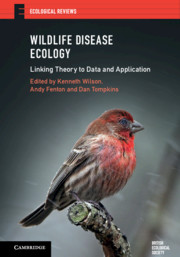Book contents
- Wildlife Disease Ecology
- Ecological Reviews
- Wildlife Disease Ecology
- Copyright page
- Contents
- Contributors
- Preface: Wildlife Disease Ecology
- Glossary of Terms
- Part I Understanding within-host processes
- Chapter one Pollinator diseases: the Bombus–Crithidia system
- Chapter Two Genetic diversity and disease spread: epidemiological models and empirical studies of a snail–trematode system
- Chapter Three Wild rodents as a natural model to study within-host parasite interactions
- Chapter Four From population to individual host scale and back again: testing theories of infection and defence in the Soay sheep of St Kilda
- Chapter Five The causes and consequences of parasite interactions: African buffalo as a case study
- Chapter Six Effects of host lifespan on the evolution of age-specific resistance: a case study of anther-smut disease on wild carnations
- Chapter Seven Sexually transmitted infections in natural populations: what have we learnt from beetles and beyond?
- Part II Understanding between-host processes
- Part III Understanding wildlife disease ecology at the community and landscape level
- Index
- Plate Section (PDF Only)
- References
Chapter Three - Wild rodents as a natural model to study within-host parasite interactions
from Part I - Understanding within-host processes
Published online by Cambridge University Press: 28 October 2019
- Wildlife Disease Ecology
- Ecological Reviews
- Wildlife Disease Ecology
- Copyright page
- Contents
- Contributors
- Preface: Wildlife Disease Ecology
- Glossary of Terms
- Part I Understanding within-host processes
- Chapter one Pollinator diseases: the Bombus–Crithidia system
- Chapter Two Genetic diversity and disease spread: epidemiological models and empirical studies of a snail–trematode system
- Chapter Three Wild rodents as a natural model to study within-host parasite interactions
- Chapter Four From population to individual host scale and back again: testing theories of infection and defence in the Soay sheep of St Kilda
- Chapter Five The causes and consequences of parasite interactions: African buffalo as a case study
- Chapter Six Effects of host lifespan on the evolution of age-specific resistance: a case study of anther-smut disease on wild carnations
- Chapter Seven Sexually transmitted infections in natural populations: what have we learnt from beetles and beyond?
- Part II Understanding between-host processes
- Part III Understanding wildlife disease ecology at the community and landscape level
- Index
- Plate Section (PDF Only)
- References
Summary
Individuals are typically coinfected with multiple parasite species. Laboratory studies have shown that coinfecting parasites can interact strongly within individual hosts with potentially serious consequences for disease progression and successful treatment. Understanding the occurrence of these interactions in natural systems and their effect on host health and parasite epidemiology in the wild are only beginning. Rodents are the ideal ‘wild’ model taxon to study these effects due to their ubiquity, high abundance, ease of capture, diagnostic assessment, and experimentation in their natural setting. Also, their close phylogenetic relatedness to the standard laboratory mouse (Mus musculus) model means that studies of wild rodents have great potential to advance our understanding of the dynamics and mechanisms of coinfection interactions. We review coinfection studies in wild rodents and compare the findings with predictions of general coinfection theory. We show that the relationship between coinfection interactions at the within-host scale and their pattern of association at the host population scale can be complex, as predicted by the general theory. Patterns of parasite association at the host population level can be poor predictors of the occurrence or direction of the underlying within-host interaction.
Keywords
- Type
- Chapter
- Information
- Wildlife Disease EcologyLinking Theory to Data and Application, pp. 58 - 90Publisher: Cambridge University PressPrint publication year: 2019
References
- 2
- Cited by



